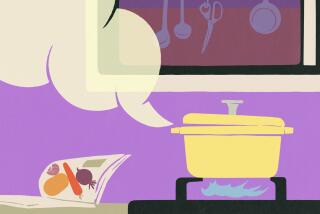The Season’s Greetings : A few of our favorites from the spring harvest.
- Share via
Artichokes--Buy those that are heavy for their size and that have the leaves close together (rather than opening up). Steam whole, or trim and saute in olive oil.
* Asparagus--Buy spears that look moist on the cut ends and where the tips are tight and firm. Thick or thin is a matter of taste, though thin asparagus does not need to be peeled. Snap off woody ends and cook in just a little water.
* Broccoli and Sprouting Broccoli--The thinner the stems, the younger and more tender the broccoli. Also, be sure the florets are blue-green, with no yellow flowers showing. Peel thicker stems, cut in pieces and either steam or saute.
* Cabbage--Heads should be heavy for their size, firm and glossy. Check stem end to make sure heads haven’t been trimmed too much (a good indication that it has been stored). Eat raw, tossed with a little olive oil and rice vinegar, or steam or saute briefly to keep it crunchy and sweet.
* Carrots--Buying carrots with the tops on gives you a clue as to how long they’ve been stored. Tops should be bright-green and firm. Carrots without tops should be deep-orange. As carrots age, the outside takes on a waxy appearance. Steam or saute--peeled or unpeeled--until tender.
* Chanterelles--These pale-orange, trumpet-shaped mushrooms are becoming more and more common in specialty supermarkets. Take care in buying them, though, since they are very fragile. Chanterelles should be firm and meaty, with no slippery wet spots. If you smell the mushroom, there should be a faint hint of apricot. Chanterelles have enough flavor that they can be fried in butter and served as you would a vegetable.
* Fava Beans--Pick firm, relatively unblemished pods (usually, the pods aren’t eaten, so a few of the almost-inevitable brown spots won’t hurt). Early in the year, when the peas inside the pods are small, they can be boiled and eaten without peeling. Later, when the peas approach dime-size, they develop a thin, tough skin that must be removed after a brief cooking.
* Green Garlic--Pick garlic that most resembles green onions--the more the bulb develops, the more aggressive the flavor. Chop fine and use raw as a garnish or as a topping for pizza or pasta.
* Morel Mushrooms--Mushrooms should be firm yet pliable--too woody or too soft is an indicator of age. Musty smells are also a tip-off of advanced age. Chop, saute with butter and shallots and serve on toast or pasta.
* Parsnips--They should be firm and ivory-colored. Avoid limp, yellowing parsnips. Braise in butter with a touch of nutmeg and serve as side dish.
* Snow Peas and Sugar Snap Peas--The pod’s the thing with these peas, since the entire vegetable is eaten. Look for outsides that are bright-green, firm and crisp. A snow pea should break crisply when folded double. These are best eaten raw, quickly sauteed fried or blanched very briefly and dressed with just a little melted butter or oil.
* English Peas--Though the pods should be firm and crisp, condition is not very important with these peas. What’s more important is how well they’re filled out. Since a pea’s sugar starts turning to starch as soon as it’s picked, eat these the day they’re bought. For really fresh peas, nothing’s better than boiling with a little bit of shallot and then a bit of butter at the end.
* Radishes--Leaves should be fresh-looking, with no dark, wilted spots. Slice radishes thin and serve on heavily buttered bread with just a little salt sprinkled over.
* Rhubarb--The cut root ends should be moist and fresh-looking; the leaves should be bright-green and crisp. Cut into one-inch pieces, toss with a little sugar and bake until melting--either by itself or with a cobbler topping.
* Spinach--Almost all spinach contains dirt, but make sure there’s not too much. Also, check where the tie gathers the leaves together--it shouldn’t be too dark. Rinse in several changes of cold water and eat raw or sauteed in butter or olive oil.
* Strawberries--Boxes of strawberries get into trouble from the bottom up. Turn the box upside-down to be sure there’s no mold and that there’s not too much juice from crushed berries. Lightly sugar and let stand for an hour at room temperature before spooning over vanilla ice cream.
More to Read
Eat your way across L.A.
Get our weekly Tasting Notes newsletter for reviews, news and more.
You may occasionally receive promotional content from the Los Angeles Times.










